Context for AI is like oxygen. Without it, you’ve got expensive guesswork dressed up as intelligence. Untagged data goes in, unlabeled information flows through, unstructured chaos dominates, and the outcome is hallucinations.
It comes from metadata that answers three questions for AI:
- What am I analyzing?
- Where did this come from?
- What should I do with it?
That context is the difference between AI that comprehends your operations and AI that’s basically a fancy search engine that mimics them.
This guide dives into AI metadata – what it is, why it’s the cornerstone of reliable intelligence, and how to build a strategy that keeps your AI grounded in truth.
Table of Contents
- What is AI Metadata?
- Why AI Metadata is a Game-Changer for Your Business
- The Symbiotic Relationship: How Metadata Fuels Powerful AI
- Common Challenges in AI Metadata Management and How to Overcome Them
- Best Practices for Your AI Metadata Strategy
- The Future is Metadata-Driven: AI, Automation, and Beyond
- Conclusion
What is AI Metadata?
Metadata is data that explains other data – the liner notes (labels or tags) that tell systems what they’re handling, its origins, and proper usage. Picture an archive filled with documents, but without a filing system, dates, or author attributions. The information exists, but metadata makes it findable, understandable, and verifiable.
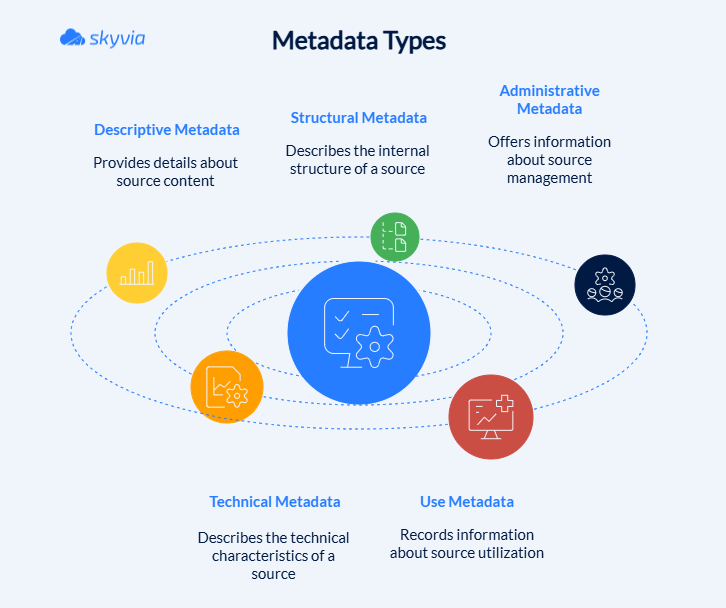
Metadata is AI’s sense of direction. It takes unstructured noise and sketches a map – what this data is, where it’s been, and how it fits with the rest. It’s the layer that turns raw data streams into insight, connecting memory to meaning.
Here’s how this data hygiene looks in practice:
| Without Metadata | With Metadata |
|---|---|
| John Doe | name: John Doe |
| USA | country: USA |
| New York | region: NY |
| Active | status: Active |
| 123 Main St | address.street: 123 Main St, address.city: New York, address.postal_code: 10001 |
| CUST-1442 | customer.id: CUST-1442 |
See the difference? The first column is just data – a jumble of facts. The second gives those facts meaning and structure. That extra layer tells both humans and machines what each element represents and how they connect.
Since the data is always open to interpretation, the more context the AI gets, the less fluctuating the results you get in the end. Provide metadata and models that traverse data intelligently, recognize vulnerabilities before encountering them, and interpret the intricate, imperfect information ecosystems we create.
Why AI Metadata is a Game-Changer for Your Business
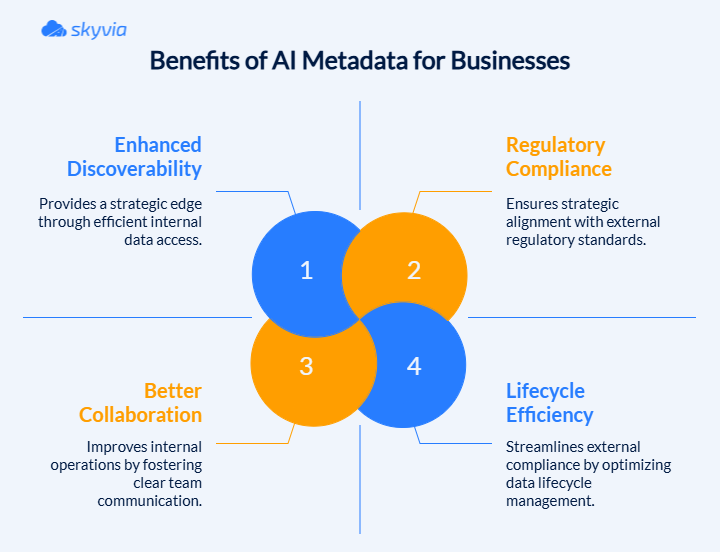
Companies pile up zettabytes of information while their teams waste hours hunting through files because nobody documented what anything means or where it lives. The problem isn’t the lack of data – it’s the lack of context.
Metadata fixes that by imposing order, adding meaning, and accelerating workflows. In other words, it’s the decoder ring.
Enhanced Data Discoverability and Searchability
Searching folders for one specific file is like looking for your keys when you’re already late. The more you look, the more it slips away. Metadata becomes a locator beacon. Add in AI-powered search, and you can talk to your data like you would to a person: “Show me last quarter’s churn metrics for Europe,” and it delivers the right thing.
AI generates tags automatically, natural language queries work like actual conversation, contextual search pulls relevant pieces together – teams stop excavating through separate systems and start catching patterns that drive decisions.
Improved Collaboration and Knowledge Sharing
Metadata is a shared dictionary – everyone flips to the same page and sees identical definitions, ending the Tower of Babel situation across departments. By documenting who owns the data, what terms mean precisely, and how things are applied, marketing, finance, and IT can finally interpret numbers consistently.
Even better, metadata keeps your institutional memory intact, so when key people leave, their knowledge doesn’t vanish with them. Your company keeps its brain even when it changes its face.
Stronger Data Governance and Compliance
About 80% of data projects crash because nobody bothered to manage metadata properly. Without clear lineage and ownership, it’s nearly impossible to prove where information came from or who changed it – a night of horrors for audits and regulations like GDPR or CCPA.
Metadata fixes that. It’s your built-in paper trail: every origin documented, every access logged, every rule tracked. Think of it as the accountant who never sleeps and never loses a receipt.
More Efficient Content Lifecycle Management
Data lives, breathes, and ages. Some of it grows wiser; some of it just grows stale. Metadata keeps the calendar – noting what’s new, what’s changed, and what’s ready to be let go, keeping your systems crisp and current.
AI metadata gives your business structure, memory, and clarity – the things every human brain relies on but few companies formalize. It turns data chaos into knowledge and ensures your organization runs on context, not confusion.
The Symbiotic Relationship: How Metadata Fuels Powerful AI
AI and metadata work together like caffeine and deadlines – each amplifying what the other accomplishes. Metadata delivers the context AI requires to make sense of information, while AI automates, enriches, and scales metadata creation exponentially.
Here’s how this synergy unfolds in practical scenarios.
Fueling AI Algorithms
Metadata operates as the answer key AI models desperately crave. It explains what each field represents, how columns connect, and what transformations happened, giving the model the lights so it’s easier to follow your directions.
- Schema: “amount_usd: decimal, UTC timestamp, customer_id: UUID.” That line alone holds the power to prevent models from merging mismatched currencies or treating ZIP codes as math problems.
- Lineage: Knowing where data came from (source systems, transformation steps, and versions) lets AI pipelines automatically select the dataset for training or retrieval-augmented generation (RAG).
- Feature hints: Metadata tracking cardinality, missing values, and drift patterns give algorithms the context needed to pick smart encoding and sampling strategies rather than applying the same approach to wildly different data.
- Embedding cues: Tags that capture topic, language, or format guide AI to file everything where it belongs – so a product review in French doesn’t end up compared to a sales chart in Excel just because they share the same folder.
As a result, you get training pipelines that don’t crash halfway, experiments that don’t repeat mistakes, and models that start three steps ahead instead of relearning basic context.
Improving AI Model Accuracy and Reducing Bias
Good metadata checks what’s coming in, flags what’s inconsistent, and documents how fair or balanced the dataset is.
- Integrity checks catch problems early: range validations, deduplication keys, unit consistency, and freshness indicators prevent corrupted inputs from slipping through.
- Coverage tracking reveals hidden imbalances: if your model dataset has ten times more examples from one region or demographic, metadata will expose that skew before it turns into bias.
- Bias audits track fairness metrics or representation gaps over time, making it easier to detect when a model starts drifting into unfair territory.
And since every dataset, label, and rule set is versioned, teams can compare experiments apples-to-apples instead of trying to remember who last “cleaned” the data. The outcome is steady model lift and fewer production surprises.
Enabling AI Model Interpretability and Trust
If the model output is the headline, metadata is the fine print that makes compliance teams breathe easier.
- Provenance logs show which tables, transformations, and prompts led to each prediction –a transparent breadcrumb trail for audit and debugging.
- Training diaries capture hyperparameters, checkpoints, and evaluation metrics (ROC, PR, calibration), turning black-box models into explainable systems. Explanation hooks store top features and SHAP/LIME summaries per user segment so teams can see why a model acted the way it did.
- Policy metadata (tags for PII, consent, and retention) enforces ethical boundaries automatically. When a model tries to access restricted data, metadata prevents this.
In short, metadata makes AI trustworthy not by being fancy, but by being accountable.
Powering Personalized Experiences
Personalization used to feel invasive. With rich metadata, it finally feels intuitive.
- Metadata captures user context (intent, device, recency, locale) so recommendation engines can finally deliver help.
- It tags content DNA – tone, region, difficulty, safety level – giving AI the ingredients to match the right message to the right person.
- It stores feedback loops like clicks, dwell time, or “don’t show again,” so the system learns from preferences instead of assumptions.
- And when retrieval models tap metadata like source credibility, freshness, or authorship, the AI doesn’t just answer faster – it answers correctly.
The result: personalization that feels human rather than creepy, where the system anticipates your needs without pretending to read your mind.
Common Challenges in AI Metadata Management and How to Overcome Them
Metadata management sounds simple until you try to scale it. Everything looks fine in a spreadsheet – until you realize half your fields are named “final_v3,” five departments track the same metric differently, and no one knows where a critical dataset came from.
Here’s what usually goes wrong:
Challenge 1: Volume and Diversity of Data
Businesses are collecting data from everywhere – smartwatches tracking warehouse workers, customer service chat logs, coffee-stained expense report PDFs, satellite images monitoring crop growth, etc.
Keeping metadata consistent is like trying to organize a warehouse where boxes keep moving themselves and relabeling overnight. Let the machines do it. Automation and AI tagging pick up where human patience runs out.
Challenge 2: Lack of Standardization
When each team names fields however they feel like it, integrations crack, lineage disappears into fog, and AI models waste time reconciling “customer_name” with “clientName” with “cust_nm” instead of analyzing anything useful.
Fix it by imposing a single metadata vocabulary and making deviation unacceptable. Centralized catalogs and governance guarantee every dataset follows the same rules instead of inventing creative new ways to describe the exact same information.
Challenge 3: Metadata Versioning
Metadata isn’t static – columns get renamed, definitions evolve, policies change. One outdated version can derail entire pipelines. It’s the tech equivalent of building a bridge on old blueprints.
Manage metadata like software. Document every schema change, ownership update, and tag adjustment, so when something breaks, you can roll back with confidence instead of interrogating five different teams about what happened.
Challenge 4: Ensuring Metadata Quality
When metadata is messy, AI predictions are too. Inconsistent tags, missing owners, and stale context all translate directly into unreliable models. Bad metadata is like feeding your model expired ingredients – you’ll still get a result, just not one you’d want to serve.
The fix is a system of quality gates:
- Automated validation to catch missing or malformed fields before they contaminate production.
- Scheduled freshness checks to ensure metadata stays current.
- Peer reviews or stewardship cycles to verify narrative layer accuracy.
Solution
The long-term fix isn’t a dozen spreadsheets or weekly syncs – it’s a centralized metadata management system (MMS).
It helps to consolidate definitions, track lineage, automate quality checks, and enforce standards in one place. Combine that with clear internal policies – naming conventions, documentation requirements, and assigned ownership – and disorder quickly turns into structure.
Data scientists spend less time debugging. AI models stop hallucinating. Executives finally trust their dashboards again.
In short: one metadata hub, one language, one truth. Everything else follows.
Here are some tools:
- OpenMetadata
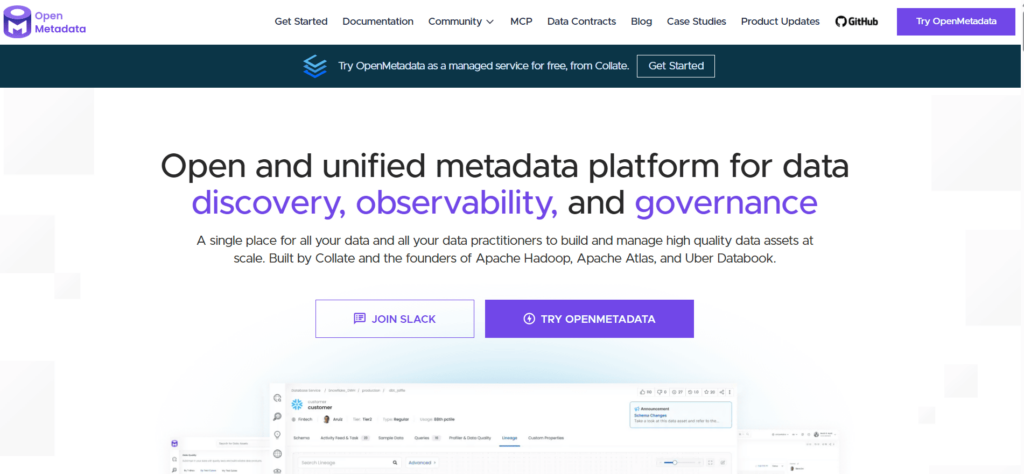
Open-source metadata management for teams that prefer building to buying.
Pros:
- No licensing costs.
- 80+ pre-built connectors.
- REST APIs for custom work.
- Built-in profiling and quality monitoring.
- Community-driven development adds features regularly.
- Full control over your metadata infrastructure.
Cons:
- Self-hosted and self-maintained.
- Enterprise polish lags behind commercial tools.
Pricing:
Free platform; pay for support contracts or managed hosting if needed.
- Atlan
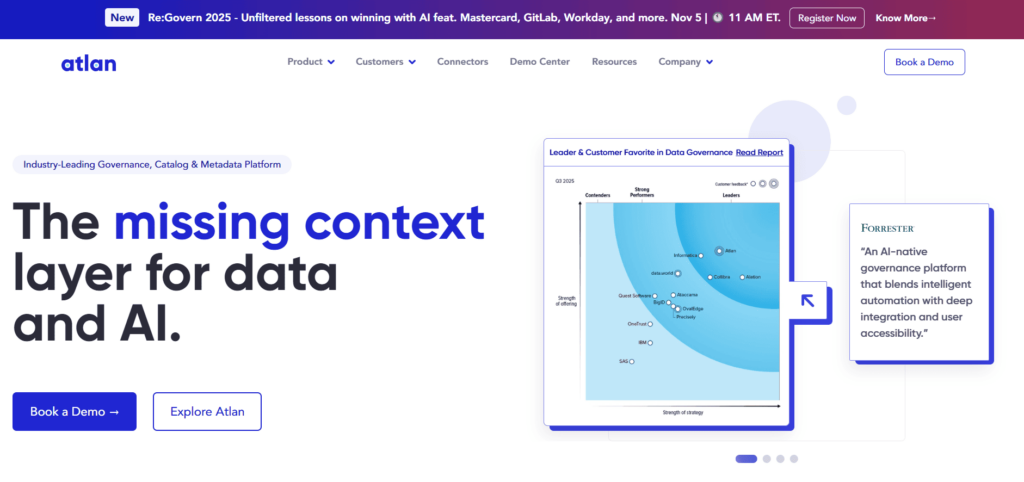
An AI-powered metadata hub that keeps data teams from drowning in their own infrastructure. It is built for organizations running Snowflake, dbt, BI tools, and needing one place to understand it all.
Pros:
- Conversational search finds data without SQL.
- Slack/Teams integration keeps metadata accessible.
- Automated lineage shows data flow.
- AI tagging organizes assets automatically.
- Scales to millions of objects.
- Governance doesn’t slow teams down, and regular updates add new capabilities.
Cons:
- More than small teams need.
- The setup isn’t instant.
Pricing:
Custom; generally $50-$100K per year for mid-market.
- Alation

Enterprise intelligence platform for compliance-critical environments in regulated industries, such as banking and healthcare, where data lineage and access controls face external scrutiny.
Pros:
- AI cataloging.
- 120+ source support.
- Audit-ready tracking.
- Quality frameworks.
- Centralized governance.
- Search acceleration 25-30%.
Cons:
- Complex deployment.
- Manual integration requirements.
- Premium cost structure.
Pricing:
Enterprise contracts, typically $100K+ yearly
Best Practices for Your AI Metadata Strategy
Good AI depends on good metadata – and good metadata doesn’t just appear overnight. It’s built through habits, structure, and a bit of automation flair. Here’s how to keep your metadata organized, trusted, and ready for AI.
Start with a Clear Plan
Strong metadata strategy for AI requires forethought, not improvisation. Align metadata work with business goals, assess your current position honestly, define what improvement looks like, and build metadata directly into AI systems, as generative AI and autonomous agents become operational.
Execution breakdown:
- Measure your starting point. Begin by defining what success actually looks like. Is it faster model training? Better compliance? More confident decision-making? Once your goal or goals take shape, work backward to identify what metadata you’ll need to get there.
- Apply maturity models, such as Gartner’s levels, to assess existing metadata.
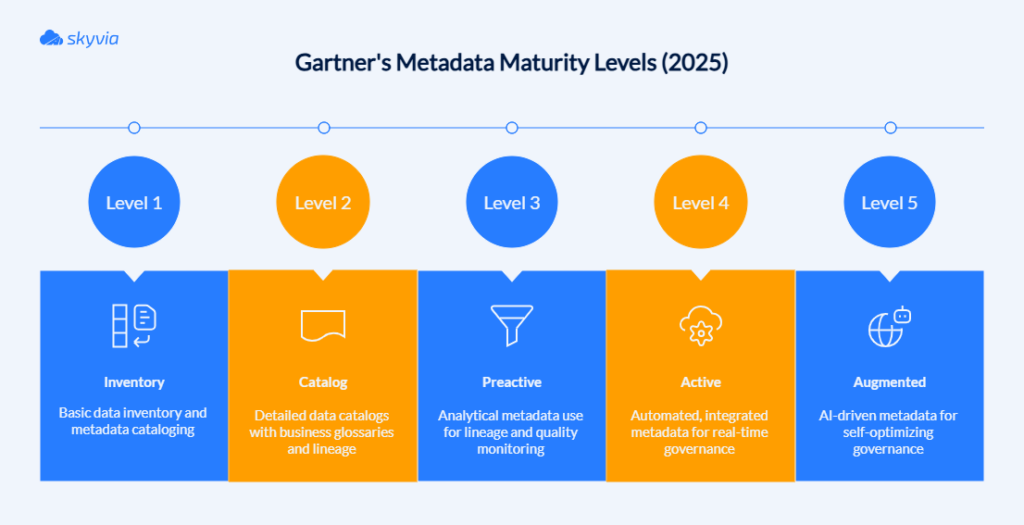
It will find gaps in lineage tracking, quality controls, and accessibility. However, don’t lose hope when the analysis proves that your data is somewhat unorganized. A rare organization can boast data that doesn’t need any cleaning and scrubbing.
- Map to real AI requirements. Fraud detection models crave provenance chains; NLP (Natural Language Processing) engines need a semantic narrative layer. Align metadata types with the problems you actually want AI to solve.
- Coordinate across functions. Bring IT, data science, and business units together early so everyone agrees on what “done” means. The most brilliant strategy fails if departments drift in different directions.
Establish a Metadata Standard
Standardization stops your metadata from turning into a free-for-all where everyone is calling for a different thing, and your AI models give up trying to figure out what’s what. Frameworks like FAIR (Findable, Accessible, Interoperable, Reusable) or MARTI (Metadata for AI Responsibility, Transparency, and Integrity) create consistent documentation for provenance, classification, and ethical concerns.
- Decide what you’re tracking. Source information, data lineage, PII (Personally Identifiable Information) markers, bias indicators – build these into every schema.
- Give someone ownership. Appoint data stewards who maintain definitions and resolve conflicts. Automation can handle the grunt work, but someone needs to be the librarian-in-chief.
- Make your AI tools cooperate. Vertex AI and similar platforms for creating machine learning models, or for quickly deploying and scaling them with both custom and pre-trained tools, should automatically enforce standards so metadata doesn’t get lost between pipeline stages.
Automate Metadata Generation
Manual metadata tagging worked when datasets were small and teams had time to spare; neither condition applies anymore. AI automation reduces tagging effort by 70%, using NLP for text content, computer vision for images, and ML models that automatically enrich metadata as new data arrives.
Practical implementation:
- Deploy AI suited to your data types. NLP extracts and classifies text, and image recognition processes visual content.
- Build into existing infrastructure. Automation should happen as part of ingestion, not as an afterthought.
- Combine machine speed with human judgment. Let automation handle volume while humans validate quality and catch edge cases.
Focus on Metadata Quality
AI accuracy lives or dies on metadata quality. Validation rigor, completeness verification, and bias detection separate functional AI from expensive disappointments.
Action steps:
- Quality Benchmarks. Evaluate completeness, accuracy, and consistency through automated platforms. You may use templates like Dataset Nutrition Labels (A diagnostic framework that allows quality evaluation to happen in minutes, not days of investigation).
- Change Tracking. Document every transformation with a graph database infrastructure.
- Continuous Cleaning. Use agentic AI for immediate data correction. It’s good practice to have integrity checks at every lifecycle point.
Make Metadata Accessible
Even the best metadata is useless if nobody can find it. Centralize it, index it, and make it as searchable as Google, but safer.
- Centralize data using a data integration platform. For example, Skyvia can become the connector between data management chaos and AI-ready infrastructure, making certain models work with information that’s not only clean but also rich in metadata, auditable, and compliant. It automates data pipelines while preserving metadata throughout integration workflows. Operating entirely cloud-based, it handles ETL, ELT, and CDC operations that move data between SaaS applications, cloud platforms, and databases without stripping away the narrative layer.
- Role-based permissions keep it secure while still allowing collaboration. Integrate metadata right into workflows, so people don’t need to go hunting for context.
Accessible metadata doesn’t just save time; it builds a culture of data fluency. Everyone starts making decisions grounded in the same truth.
The Future is Metadata-Driven: AI, Automation, and Beyond
Metadata is becoming the central nervous system of AI ecosystems. Now, it is the difference between AI that “acts smart” and AI that truly understands.
The Rise of a Semantic Layer
AI still often misreads data. However, the semantic layer can guide it in the right direction. It’s an abstraction built on metadata that gives AI a shared dictionary of meaning. It turns raw tables into concepts, relationships, and rules that the machine can actually reason with.
Gartner’s 2025 report calls semantic layers the cornerstone of enterprise AI, predicting that by 2028, 15% of daily work decisions will be made autonomously via agentic AI – and this layer is what makes that possible.
Meanwhile, the Open Semantic Interchange (OSI) initiative – backed by Snowflake, Salesforce, dbt Labs, Tableau, and BlackRock – standardizes semantic metadata so every AI tool speaks the same structured language.
Semantic layer is metadata’s evolution from translator to teacher – giving AI the vocabulary to discuss data, not just ingest it.
Automated Data Catalogs
Keeping track of petabytes of data manually is impossible. That’s why metadata management is getting an AI assistant of its own: the automated catalog.
These catalogs crawl your systems, identify new datasets, classify them, and tag them in real time. The global data-catalog market is $1.68 billion in 2025 and is forecasted to explode to $13.4 billion by 2035, as automation becomes the only way to tame the “data maze,” where 80 % of enterprise data remains unstructured or undiscovered.
AI handles the grunt work: it maps lineage, flags anomalies, and refreshes metadata while humans sleep.
Gartner envisions that these catalogs will manage 20% of all metadata processes by 2026. In other words: soon your catalog won’t just tell you where data lives – it’ll let you know what it means and how to use it.
The Role of Metadata in Generative AI
Together, metadata and AI form a closed feedback loop – one curates context; the other refines it. Metadata keeps AI grounded; AI keeps metadata growing. In business settings, this makes all the difference. As you can see, context is in the air today. However, this duo brings more benefits:
- Improves findability – allows AI to identify the most relevant, reliable data sources quickly and accurately.
- Guarantees proper interpretation – makes certain AI models understand data correctly and deploy it meaningfully rather than misreading.
- Enables intelligent generation – permits AI to pull key elements, comprehend intent, and deliver outputs fitting actual needs.
- Powers audience-specific content – supplies information AI requires to personalize outputs for different narrative layers or users.
- Improves dependability – decreases hallucinations and off-base responses by rooting AI in structured, significant metadata.
AI and metadata integration rely on several core pieces working in concert to improve how data gets managed and governed:
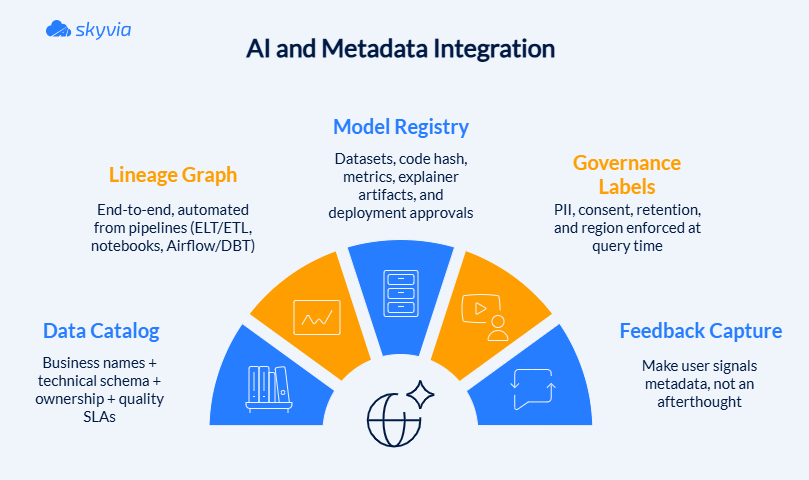
In short, metadata gives generative AI its conscience – a system of context and memory that transforms imitation into intelligence.
Conclusion
AI only delivers real value when it truly understands the data it’s working with – and that understanding comes from metadata.
We’ve seen how AI metadata transforms chaos into clarity: it defines what data means, keeps it trustworthy through governance and lineage, and gives AI the context it needs to think rather than guess. The payoff is huge – faster discovery, fewer biases, cleaner compliance, and AI outputs you can actually rely on.
But context doesn’t build itself. It starts with integrating, synchronizing, and documenting your data properly – and that’s where Skyvia steps in. As a cloud-based data integration and management platform, Skyvia automates the extraction, synchronization, and transformation of data across your systems – while preserving and enriching the metadata AI depends on.
If you want your AI to stop guessing and start understanding, start by getting your metadata right – and let Skyvia handle the heavy lifting.
F.A.Q. for AI Metadata
How does metadata improve the accuracy of AI models?
It gives AI the missing context. With metadata, models know what fields mean and how they connect – so predictions stop guessing and start reasoning.
What are some practical applications of metadata in AI for businesses?
Smarter searches, cleaner analytics, and more relevant personalization. Metadata helps every AI system act with context instead of confusion.
How does metadata impact generative AI?
Metadata tells GenAI what’s true, current, and relevant – so the output sounds human and makes sense.
What are the main challenges in managing AI metadata?
Too much data, too few standards, and constant change. Without structure, even great AI ends up lost in its own metadata maze.
How can a business get started with an AI metadata strategy?
Begin by mapping what you already have, agree on naming rules, and use integration tools like Skyvia to sync and enrich data automatically.


